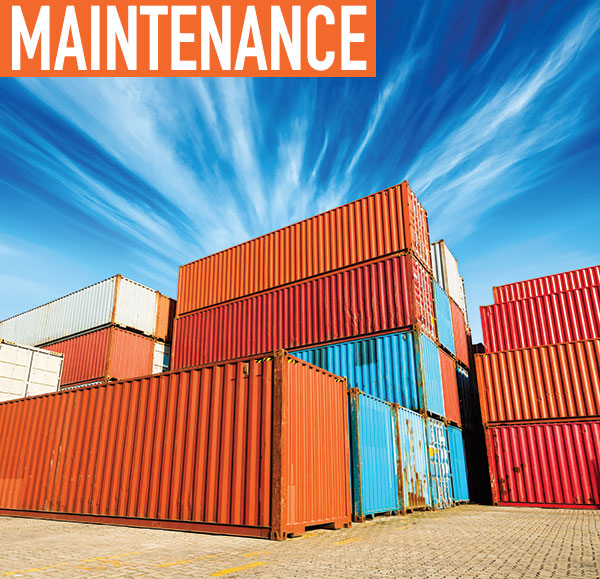Here are some interesting facts about a product that is a great solution for one industry but has become a challenge for another; namely the work truck industry.
- Over 12 million of them arrive on US shores each year.
- They make a combined 200 million trips worldwide, annually.
- The majority have a service life of 10-12 years but a life expectancy of 20-25 years.
- They are measured in units called TEUs.
- 97% are manufactured in China.
- Each one has a serial number.
- 90% of everything we buy arrive in them.
From that last fact, you probably figured out the product is a shipping container, officially called an ISO Dry Storage Container—sometimes called a Conex.
They are sized or measured in TEUs so that a Twenty-foot Equivalent Unit is a 20-ft container or 1 TEU, therefore a 40-ft container is 2 TEU.
After 10 to 12 years of sea service (some shipping lines may be shorter), they are sold off. Retired containers are converted into housing, portable schools, restaurants, emergency centers, workshops, offices, and most often, used for storage.
Sometimes fleet owners purchase them to store excess parts and materials—that is where the challenge arrives.
BEYOND ORIGINAL USE
My first experience with these containers goes back to when we used them in Vietnam in 1969 and 1970. They were owned by SeaLand Service, which was part of RJ Reynolds Tobacco Company but was later acquired by Maersk Line. After delivering 1,200 shipping containers of equipment and munitions a month to Vietnam, some of the containers were left behind for use by the GIs and civilian employees where we used them as storage for motor pool parts, ammo storage, etc.
We nicknamed them “sweat boxes” because in the tropical sun they would produce extreme heat inside as well as rain from dripping condensate. The other issue with these containers is excess heat. The average difference between the internal container temperature and external temperature is about 15 degrees F, as research has shown. So, when it was 100 degrees F outside, it could easily be 115-120 degrees F inside with condensate dripping like rain from the ceiling.
Here we are 47-48 years later, and we finally solved the problem with the sweat boxes … right? No way!
Granted, most shipping containers won’t be in the hot conditions of the tropics, but the ceilings of many shipping containers will easily reach well over 100 degrees F in the summer. Visit YouTube and watch some of the shipping container temperature videos for a surprising display of the effects of the hot sun on the ceiling metal. This causes a Dew Point issue where moisture begins to condense about six inches near the ceiling called the “sweat zone” due to the extreme temperature of the metal roof. The high heat causes droplets to form on the ceiling and upper band of the walls. This produces what is commonly called “container rain” or “container sweat.”
EXTRA STORAGE
Some companies rely on shipping containers for supplemental or auxiliary storage, such as a Michigan-based contractor who owns 35 containers.
If we examine what parts and materials could be sensitive to excessive temperature and humidity, where shelf life would reduce, we find a range of things that are commonly stored:
- Epoxy and adhesives
- Lubricants (grease and oils)
- Hydraulic fluids
- Paints (aerosol and brush type)
- Gaskets
- O-rings, seals
- Filters (oil, gas, etc.)
Most of these items should be kept at a temperature of less than 80 degrees F and a relative humidity of 50-60%. We can see that a traditional shipping container will exceed these temperatures, and by reaching Dew Point the humidity level will be in excess of 60%.
For example, oil filter medium can get dry and crack or moist based on humidity or excess temperature. The cork, rubber, or silicone seals can become brittle from serious temperature and humidity ranges. Although filter companies won’t commit to exact degradation amounts, estimates are that long-term storage container storing would reduce the average life expectancy from the normal five years shelves to 50%.
TEMP AND HEAT SOLUTIONS
Let’s examine some ways to keep the temperature and humidity in check. A common way to manage condensation is to manage the air flow to keep the inside and outside of the container the same, or close to the same temperature. Remember, its temperature differential will cause the Dew Point problem. Since the main keys to condensation control are ventilation and/or dehumidification, let’s look at some different solutions to the problem:
Solution One: Storage Container Vents Adding a ventilation system into a storage container is a common way to keep the inside of the container dry since most containers have no venting. Adding four storage container vents, two on each end of the container, allows an ample amount of airflow and does a great job keeping the contents of the container dry. There are two main vent types: fixed and louvered. Fixed vents are simple and effective, but you can’t alter airflow because they are fixed. Louvered vents are more expensive, but they allow some flexibility over airflow. Both can be purchased online.
Solution Two: Air Conditioning Units If you’re using the container for an office or work shop, and have a power source for the container, you may want to consider having some type of HVAC unit. A basic air conditioner such as a simple 5,000 BTU unit would suffice.
Solution Three: Dehumidifier If you have electrical power inside of your container you can always buy a small dehumidifier and place it inside of the container. The reservoir will need to be emptied occasionally, but the costs are limited to the initial investment and the monthly power cost. It would be ideal to pipe the discharge line so that the condensed water can run out of the unit, which requires far less maintenance.
Solution Four: Pole Container Desiccant Available in various sizes and good for a few months, Pole Desiccants come in different configurations. There are hanging-type desiccants that are available in bags, poles, and strips. These products absorb up to three times their weight in moisture and trap it as a thick gel that will not spill or drip.
Pole variations have calcium chloride salts contained within the pole to absorb moisture when a silver protection foil is peeled off. The collected moisture in the form of a gel is permanently dumped into its built-in “tank” for evacuation. The tank must be replaced when the salts are exhausted.
Solution Five: Painting the Container White Painting the container white will reduce the heating/cooling cycle between day and night. This reduces the “breathing” of the container. This is a process that happens when the container warms up, air expands and escapes between the seals, but when it cools, air is drawn into the container.
You should also consider using zinc paint as applying a zinc paint coat can slow the process of shipping container rust significantly. By the process of “cathodic protection,” the zinc slows the process of the rusting of the underlying steel. Quality zinc paint should contain at least 90% dry zinc powder. Mounting a container on ConFoot legs would allow the bottom to be easily painted. Also, elevating it off of the ground eliminates any reaction with the soil.
Solution Six: Kitty Litter (Bentonite and Silica) Open one bag at one end of the container and another bag at the other end of the container. It will absorb moisture until it is satiated, so you will have to monitor this one periodically. It’s inexpensive though, as you can buy a 40-lb bag for around $25. You will need to monitor it at least monthly based on humidity level.
DOGGIE RULE
Try to avoid storing items with a definite shelf life, but if you must, control the environment. Remember the Doggie Rule when looking to store items in the storage container. If you wouldn’t put your pet doggie in the container with food and water for a prolonged time, don’t store the item in there (even if you provide it with food and water).
ABOUT THE AUTHOR
Preston Ingalls is president and CEO of TBR Strategies, LLC, a Raleigh, North Carolina-based maintenance and reliability firm specializing in the construction and oil and gas industries. Preston can be reached at pingalls@tbr-strategies.com, or visit www.tbr-strategies.com.
_______________________________________________________________________
MODERN WORKTRUCK SOLUTIONS: FEBRUARY 2018 ISSUE
Did you enjoy this article?
Subscribe to the FREE Digital Edition of Modern WorkTruck Solutions magazine.
![]()





